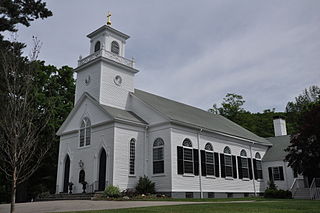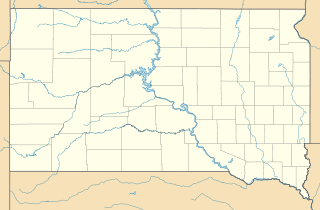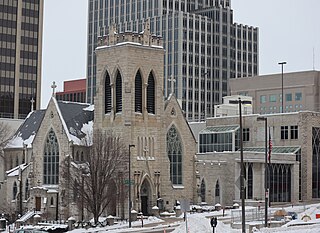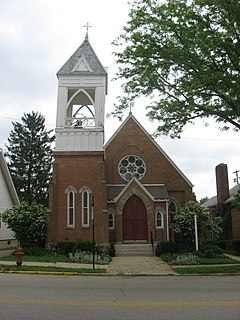
Carpenter Gothic, also sometimes called Carpenter's Gothic or Rural Gothic, is a North American architectural style-designation for an application of Gothic Revival architectural detailing and picturesque massing applied to wooden structures built by house-carpenters. The abundance of North American timber and the carpenter-built vernacular architectures based upon it made a picturesque improvisation upon Gothic a natural evolution. Carpenter Gothic improvises upon features that were carved in stone in authentic Gothic architecture, whether original or in more scholarly revival styles; however, in the absence of the restraining influence of genuine Gothic structures, the style was freed to improvise and emphasize charm and quaintness rather than fidelity to received models. The genre received its impetus from the publication by Alexander Jackson Davis of Rural Residences and from detailed plans and elevations in publications by Andrew Jackson Downing.

St. Mary's Episcopal Church and Cemetery is a historic church and cemetery at 258 Concord Street, in the village of Newton Lower Falls, Newton, Massachusetts. St. Mary's Parish was formed in 1811. The church, built in 1813–14 and restyled in 1838, is the oldest church in Newton, and is a fine example of Gothic Revival/Federal style architecture. The cemetery, which dates from 1812, is the oldest non-government-owned cemetery in Newton. The property was listed on the National Register of Historic Places in 1980.

St. Anne's Episcopal Church is a historic church at 29 Church Street in Calais, Maine. Built in 1853, it is a locally distinctive example of Carpenter Gothic architecture, and is the only known statewide work of architect James Renwick, Jr. The church building was listed on the National Register of Historic Places in 1982. It is a member of the Episcopal Diocese of Maine; its pastor is the Rev. Sara Gavit.

Holy Fellowship Episcopal Church is an historic Carpenter Gothic Episcopal church built in 1886 near Greenwood on the Yankton Indian Reservation in Charles Mix County, in the U.S. state of South Dakota. In 1975 it was added to the National Register of Historic Places.

St. Ann's Episcopal Church is an historic Episcopal church located on Church Street in Richford, Vermont, in the United States. Built in 1883, it is an architecturally a distinctive blend of Queen Anne and Gothic Revival architecture. On March 12, 2001, it was added to the National Register of Historic Places. The church is a defunct mission of the Episcopal Diocese of Vermont; no services are held there.

The Episcopal Diocese of South Dakota is a diocese of the Episcopal Church with jurisdiction over the state of South Dakota.

St. Philip's Episcopal Church is an historic Episcopal church located in the High Hills of Santee, in the antebellum summer resort community of Bradford Springs in Lee County, South Carolina, about six miles north of Dalzell.

Trinity Cathedral is located in Downtown Omaha, Nebraska. Nebraska's first Episcopal parish, Trinity was established in 1856, and became the state's first Episcopal cathedral in 1872. Designed by noted English architect Henry G. Harrison in 1880, the cathedral was consecrated on November 15, 1883. It was added to the National Register of Historic Places in 1974. Today Trinity Cathedral is considered one of the most beautiful churches in Omaha.

The United Methodist Church and Parsonage are a historic United Methodist church and its adjacent historic parsonage located on a 2-acre tract on the corner of East Main Street and Smith Avenue in Mount Kisco, Westchester County, New York. The New Castle Methodist Episcopal Church was designed by J. King in the Carpenter Gothic style of architecture and built in 1868 by Edward Dauchey, while the parsonage, designed in the Victorian style of architecture, was built in 1871. Today the church is known as the United Methodist Church of Mt. Kisco. On November 4, 1982, both the church building and the parsonage were listed on the National Register of Historic Places as a single filing.

The Church of the Assumption is an historic Carpenter Gothic style Roman Catholic church located on US 41, 400 feet east of M-26 in Phoenix in Houghton Township, Michigan. It is also known as the Phoenix Church. The church was listed on the National Register of Historic Places in 2000.

The Episcopal Church of the Advent / St. John's Chapel is an historic Carpenter Gothic style Episcopal church building located at Franklin and Washington streets in Cape May, Cape May County, New Jersey, United States. Its board and batten siding, steep roofs, lancet windows and rose window are distinguishing features of Carpenter Gothic style architecture, although it lacks the usual belfry tower front entrance. Designed by the architect Henry Sims, it was built by Richard Soder beginning in 1865 for St. John's Chapel, a "summer chapel", which had been organized two years earlier. It was not consecrated, however, until 1871.

St. Thomas Episcopal Church is a historic Episcopal church building located at 2720 Slaterville Road, east of the post office in Slaterville Springs in the town of Caroline, Tompkins County, New York. It was built in 1893 and is an example of the Carpenter Gothic style of architecture, sometimes called the High Victorian Gothic. It features include, a steeply sloped roof, lancet windows, lancet covered entry through a side steepled belfry, all of which are typical of the Carpenter Gothic style.

Christ Episcopal Church is an historic Carpenter Gothic Episcopal church located at 425 North Cherry Street in Monticello, Florida in the United States. Designed by T.M. Feruson of Georgia in the Carpenter Gothic style of architecture with some stick-style detailing, it was built in 1885 to replace a previous church building which burned in 1883. Its steep roof, lancet windows and side belfry and entrance are typical of Carpenter Gothic churches. The church had been organized in 1840 by local Episcopalians who had previously held lay services in their homes. It is still an active parish in the Episcopal Diocese of Florida. The Rev. Mal Jopling is its current rector.

The Church of Our Saviour is a historic Episcopal parish in the village of Mechanicsburg, Ohio, United States. Founded in the 1890s, it is one of the youngest congregations in the village, but its Gothic Revival-style church building that was constructed soon after the parish's creation has been named a historic site.

St. Paul's Episcopal Church is a parish church in the Diocese of Iowa. The church is located in Durant, Iowa, United States. The church building and parish hall have been listed on the National Register of Historic Places since 1985.

St. George's Episcopal Church is a historic Episcopal Church building located in Le Mars, Iowa, United States. Designed in the Carpenter Gothic style of architecture, it was erected in 1881. It is one of the few remnants of the English era in Le Mars' early history. The church building was listed on the National Register of Historic Places in 1976.

St. Stephen's Episcopal Church is an historic Carpenter Gothic style Episcopal Church church building located in Newton, Iowa, United States. Completed in 1881, it was built by the contractor David S. Strover and master carpenter Joe Stevens. On September 22, 1977, it was listed on the National Register of Historic Places. It serves a parish church in the Episcopal Diocese of Iowa.

St. John's Catholic Church, built in 1915, is a historic Carpenter Gothic style Roman Catholic church building located in Paxton, Dickens Township near Dallas, Gregory County, South Dakota. Its steep roof, lancet windows and belfry and entrance are typical of Carpenter Gothic churches. In 1973 it was closed but a year later it was given to a group of former parishioners who agreed to maintain it and its adjoining cemetery. The church and the cemetery are the only remnants of the former community of Paxton.

The Church of the Good Shepherd built in 1880 is an historic Episcopal church located at 331 Lake Avenue in Maitland, Orange County, Florida. Designed by renowned New York architect Charles C. Haight in the Carpenter Gothic style of architecture, it was built largely through the efforts of the Right Reverend Henry Benjamin Whipple, the first bishop of Minnesota, who began wintering in Maitland in the 1870s. Its board and batten exterior walls and lancet windows are typical of Carpenter Gothic architecture, but its belfry centered over the altar area is unusual. The church was consecrated on March 17, 1883, and Bishop Whipple conducted regular services there each winter for the rest of his life. In 1967, a new modern church designed by Nils M. Schweizer was built to complement the original structure, which since then has served as a chapel. On March 28, 2011, the 1880 church was added to the National Register of Historic Places.

St. Mark's Pro-Cathedral is an Episcopal Church building located in Hastings, Nebraska, United States. It has been listed on the National Register of Historic Places since 1987.






















